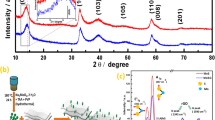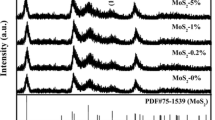Abstract
The aim of the present study is to increase the discharge capacity of Mg-air battery via electrolyte using water dispersible nano MoS2 sheet as electrocatalyst since MoS2 shows enhanced anodic behaviour. The nano MoS2 sheet was effectively synthesised by polymer exfoliation technique employing ball milling and then converted into water dispersible form by adjusting its pH value above 10. The structure, morphology, crystallinity, particle size distribution and surface area of water dispersible nano MoS2 (WDNMoS2) were characterised comprehensively employing different characterisation techniques. A detailed analysis of corrosion, impedance and charge discharge performance of Mg-air battery were carried out with and without water dispersible nano MoS2 (WDNMoS2) in MgCl2 electrolytes. The charge-discharge capacity of Mg-air battery is enhanced nearly 18% in case of addition of WDNMoS2 (1170 mAh g−1) to aqueous MgCl2 electrolytes compared with aqueous MgCl2 electrolyte (990 mAh g−1).

ᅟ














Similar content being viewed by others

References
Kim K, Cho YH, Eom SW, Kim HS, Yeum JH (2010) Anions of organic acids as gas suppressants in zinc–air batteries. Mater Res Bull 45:262–264
Siva P, Prabhu P, Selvam M, Karthik S, Rajendran (2017) V Electrocatalytic conversion of carbon dioxide to urea on nano FeTiO3 surface. Ionics 23:1871–1878
Smith JG, Naruse J, Hiramatsu H, Seigel DJ (2016) Theoretical limiting potential in mg/O2 batteries. Chem Mater 28:1390–1401
Song SQ, Liang L, Zhou W, Sun G, Xin Q, Stergiopolous V, Tsiakaras P (2005) Direct methanol fuel cells: The effect of electrode fabrication procedure on MEAs structural properties and cell performance. J Power Sources 145:495–501
Wu Y, Wang T, Zhang Y, Xin S, He X, Zhang D, Shuri J (2016) Electrocatalytic performance of g-C3N4-LaNiO3 composite as bi-functional catalysts for lithium-oxygen batteries. Sci Rep 2:1–8
Bucur CB, Gregory T, Oliver AG, Muldoon J (2015) Confession of a magnesium battery. J Phys Chem Lett 18:3578–3591
Zhang T, Tao Z, Chen J (2014) Magnesium air batteries: from principle to application. Mater Horiz 1:196–206
Vielstich W, Lamm A, Gasteiger HA (2003) Handbook of fuel cells fundamentals, technology and applications. Wiley, Chichester
Siva P, Prabu P, Karthik S, Arunkumar PS, Rajendran V (2018) Ultrathin sheet structure Ni-MoS2 anode and MnO2/water dispersion graphene cathode for modern asymmetrical coin cell supercapacitor. J Alloy Compd 731:936–944
Greeley J, Jaramillo TF, Bonde J, Chorkendorff I, Norskov JK (2006) Computational high-throughput screening of electrocatalytic materials for hydrogen evolution. Nat Mater 5:909–913
Merk D, Hu X (2011) Recent developments of molybdenum and tungsten sulfides as hydrogen evolution catalysts. Energy Environ Sci 4:3878
Vrubel H, Merki D, Hu X (2012) Hydrogen evolution catalyzed by MoS3 and MoS2 particles. Energy Environ Sci 5:6136
Tang Q, Jiang D (2016) Mechanism of hydrogen evolution reaction on 1T-MoS2 from first principles. ACS Catal 6:4953–4961
Splendiani A, Sun L, Zhang Y, Li T, Kim J, Chim CY, Galli G, Weng F (2010) Emerging photoluminescence in monolayer MoS2. Nano Lett 10:1271–1275
Hone J, Shane J, Heinz TF, Make KF, Lee C (2010) Atomically thin MoS2: a new direct-gap semiconductor. Phys Rev Lett 105:136805
Kibsgaard J, Jramillo TF, Besenbacher F (2014) Building an appropriate active site motif inti hydrogen evolution catalyst with thiomolybdate [Mo3S13]2−. Nat Chem 6:248–253
Kibsgaard J, Chen Z, Reinekce BN, Jaramillo TF (2012) Engineering the surface structure of MoS2 to preferentially expose active edge sites for electrocatalysis. Nat Mater 11:963–969
Liu L, Kumar SB, Ouyang Y, Guo J (2011) Performance limits of monolayer transition metal dichalcogenide transistors. IEEE Trans Electron Devices 58:3042–3047
Ding Y, Wang Y, Ni J, Shi L, Shi S, Tang Y (2011) First principles study of structural, vibrational and electronic properties of graphene-like MX2 (M=Mo, Nb, W, ta; X=S, se, Te) monolayers. Physica B 406:2254–2260
Ataca C, Sahin H, Ciraci S (2012) Stable, single-layer MX2 transition-metal oxides and dichalcogenides in a honeycomb-like structure. J Phys Chem C 116:8983–8999
Lebègue S, Eriksson O (2009) Electronic structure of two-dimensional crystals from ab initio theory. Phys Rev B 79:15409
Frey GL, Reynolds KJ, Friend RH, Cohen H, Feldman Y (2003) Solution-processed anodes from layer-structure materials for high-efficiency polymer light-emitting diodes. J Am Chem Soc 125:5998–6007
Ramasubramaniam A (2012) Large excitonic effects in monolayers of molybdenum and tungsten dichalcogenides. Phys Rev B 86:115409
Cheiwchanchamnangij T, Lambrecht WRL (2012) Quasiparticle band structure calculation of monolayer, bilayer and bulk MoS2. Phys Rev B 85:205302
Li H (2012) Fabrication of single- and multilayer MoS2 film-based field-effect transistors for sensing NO at room temperature. Small 8:63–67
Xiao D, Liu GB, Feng W, Xu X, Yao W (2012) Coupled spin and valley physics in monolayers of MoS2 and other group-VI dichalcogenides. Phys Rev Lett 108:196802
Zhang H, Tian Y, Zhao J, Cai Q, Chen Z (2017) Small dopants make big differences: enhanced electrocatalytic performance of MoS2 monolayer for oxygen reduction reaction (ORR) by N– and P–Doping. Electrochim Acta 225:543–550
Gu H, Huang Y, Zuo L, Fan W, Liu T (2016) Graphene sheets wrapped carbon nanofibers as a highly conductive three-dimensional framework for perpendicularly anchoring of MoS2: advanced electrocatalysts for hydrogen evolution reaction. Electrochim Acta 219:604–613
Voiry D, Salehi M, Silva R, Fujita T, Chen M, Asefa T, Vivek B, Shenoy, Chhowalla M (2013) Conducting MoS2 Nanosheets as catalysts for hydrogen evolution reaction. Nano Lett 13:6222–6227
Vattikuti SVP, Byon C, Reddy CV, Venkatesh B, Shim J (2015) Synthesis and structural chracterisation of MoS2 nanosphere and nanosheets using solvothermal method. J Mater Sci 50:5024–5038
Wang D, Zhang X, Shena Y, Wuab Z (2016) Ni-doped MoS2 nanoparticles as highly active hydrogen evolution electrocatalysts. RSC Adv 6:16656–16661
Windom BC, Sawyer WG, Hahn DW (2011) A Raman spectroscopic study of MoS2 and MoO3: applications to Tribological systems. Tribol Lett 42:301–310
Li H, Zhang Q, Yap CCR, Tay BK, Edwin THT, Olivier A, Baillargeat D (2012) From bulk to monolayer MoS2: evolution of Raman scattering. Adv Funct Mater 22:1385–1390
Naveenkumar R, Siva P, Prabu P, Rajendran V (2018) Enhancing the tribological characteristics of the lubricant oil using Ni-promoted MoS2 nanosheets as nano additives. Tribol Int 118:314–328
Panitz JKG, Pope LE, Lyons JE, Staley DJ (1988) The tribological properties of MoS2 coatings in vacuum, low relative humidity, and high relative humidity environments. J Vac Sci Technol A 63:1166–1170
Vattikuti SVP, Byon C (2015) Synthesis and characterization of molybdenum disulfide Nanoflowers and Nanosheets: Nanotribology. J Nanomater 2015:1–11
Nagaraju G, Tharamani CN, Chandrappa GT, Livage J (2007) Hydrothermal synthesis of amorphous MoS2 nanofiber bundles via acidification of ammonium heptamolybdate tetrahydrate. Nanoscale Res Lett 2:461–468
Zhou X, Wana L, Guo YG (2013) Synthesis of MoS2 nanosheet–graphene nanosheethybrid materials for stable lithium storage. Chem Commun 49:1838–1840
Maugéa F, Lamotte J, Nesterenko NS, Manoilova O, Tsyganenko AA (2001) FT-IR study of surface properties of unsupported MoS2. Catal Today 70:271–284
Jain A, Tripathi SK (2015) Nanoporous activated carbon from sugra cane waste for supercapacitor application. J Energy Storage 4:121–127
Wu S, Zeng Z, He Q, Wang Z, Wang SJ, Du Y, Yin Z, Sun X, Chen W, Zhang H (2012) Electrochemically reduced single-layer MoS2 Nanosheets: characterization, properties, and sensing applications. Small 8:2264–2270
Li T, Galli G (2007) Electronic properties of MoS2 nanoparticles. J Phys Chem C 111:16192–16196
Bott AW (1998) Electrochemistry of semiconductors. Curr Sep 17:87–91
Bothra P, Pandey M, Pati SK (2016) Size-selective electrocatalytic activity of (Pt)n/MoS2 for oxygen reduction reaction. Catal Sci Technol 6:6389–6395
Hu Y, Hua DHC (2016) Synthesizing 2D MoS2 Nanofins on carbon nanospheres as catalyst support for proton exchange membrane fuel cells. Sci Rep 6:1–10
Wu J, Liu M, Chatterjee K, Hackenberg KP, Shen J, Zou X, Yan Y, Lou J, Ajayan PM (2016) Exfoliated 2D transition metal disulfides for enhanced Electrocatalysis of oxygen evolution reaction in acidic medium. Adv Mater Interfaces 3:1500669
Chia X (2014) Electrochemistry of MoS2 and its activation for electrochemical applications. Nanyang Technological University, Singapore
Ghuman KK, Yadav S, Singh CV (2015) Adsorption and dissociation of H2O on Monolayered MoS2 edges: energetics and mechanism from ab initio simulations. J Phys Chem C 119:6518–6529
Richey FW, McCloskey BD, Luntz AC (2016) Mg anode corrosion in aqueous electrolytes and implications for mg-air batteries. J Electrochem Soc 163:958–963
Author information
Authors and Affiliations
Corresponding author
Rights and permissions
About this article
Cite this article
Prabhakaran Shyma, A., Palanisamy, S., Rajendhran, N. et al. Enhanced discharge capacity of Mg-air battery with addition of water dispersible nano MoS2 sheet in MgCl2 electrolyte. Ionics 25, 583–592 (2019). https://doi.org/10.1007/s11581-018-2691-3
Received:
Revised:
Accepted:
Published:
Issue Date:
DOI: https://doi.org/10.1007/s11581-018-2691-3



